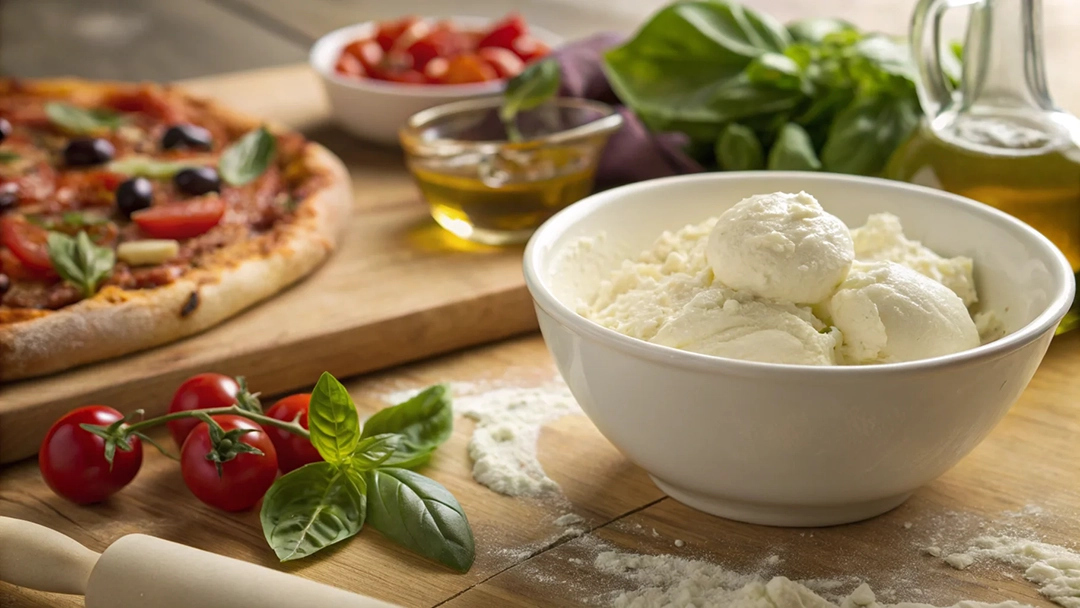Pizza is one of the most beloved dishes worldwide, but did you know it can be reinvented with a healthier twist? Many food enthusiasts wonder, Can cottage cheese be used on pizza? The short answer is: absolutely! Cottage cheese is not only a nutritious alternative to traditional cheeses but also adds a unique flavor and texture to your pizza creations. In this article, we’ll explore everything you need to know about using cottage cheese on pizza, from its health benefits to creative recipe ideas. Let’s dig in!
Table of contents
- Introduction to Using Cottage Cheese on Pizza
- How to Use
- Making this recipes
- Creative Variations
- Nutritional Benefits
- Creative Cottage Cheese Pizza Variations
- Nutritional Benefits of Using Cottage Cheese on Pizza
- Common Mistakes to Avoid
- Frequently Asked Questions
- Conclusion: Why Cottage Cheese Deserves a Spot on Your Pizza
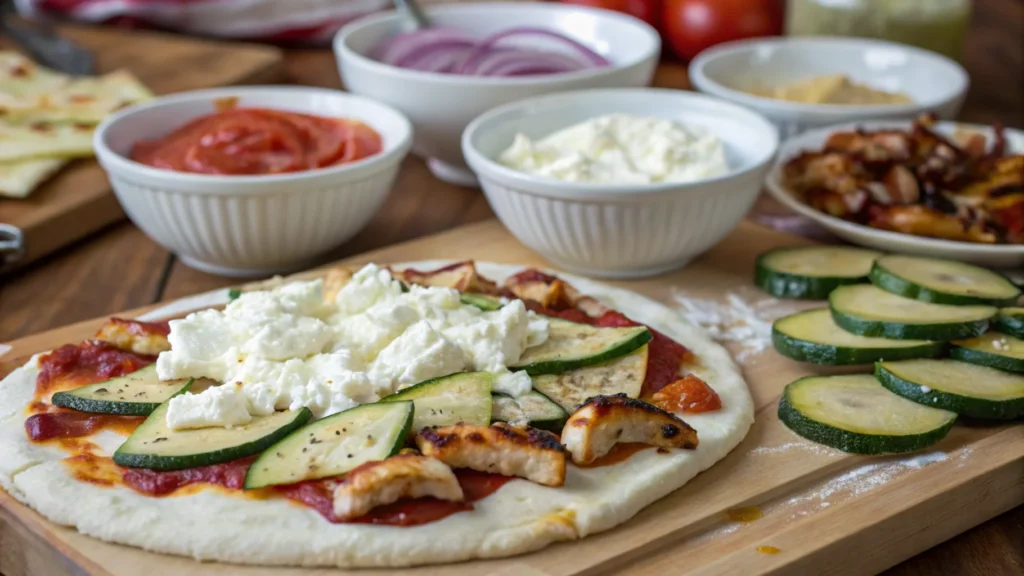
Introduction to Using Cottage Cheese on Pizza
Why Consider Cottage Cheese for Pizza?
Cottage cheese is a game-changer for anyone looking to make their pizza healthier without sacrificing taste. Packed with high-quality protein and low in calories, this versatile ingredient is a great option for fitness enthusiasts, dieters, or anyone seeking something new.
Unlike traditional pizza cheeses like mozzarella, cottage cheese adds a creamy texture with a slightly tangy taste that pairs beautifully with various toppings. Moreover, it’s naturally lower in fat, making it a perfect choice for health-conscious pizza lovers.
How Cottage Cheese Differs from Traditional Pizza Cheeses
Compared to staples like mozzarella and ricotta, cottage cheese stands out for its nutritional profile and texture. While mozzarella melts into a stringy, gooey layer, cottage cheese remains soft and creamy. This makes it ideal for dishes where you want a rich, velvety consistency.
Additionally, cottage cheese as a pizza topping offers unique benefits:
- It blends seamlessly into sauces, creating a creamy base for your pizza.
- Its mild tanginess complements both savory and sweet toppings.
- It’s easier to digest for those who are sensitive to higher-fat cheeses.
Using cottage cheese on pizza is a fantastic way to shake up your usual recipe while keeping it nutritious and flavorful.
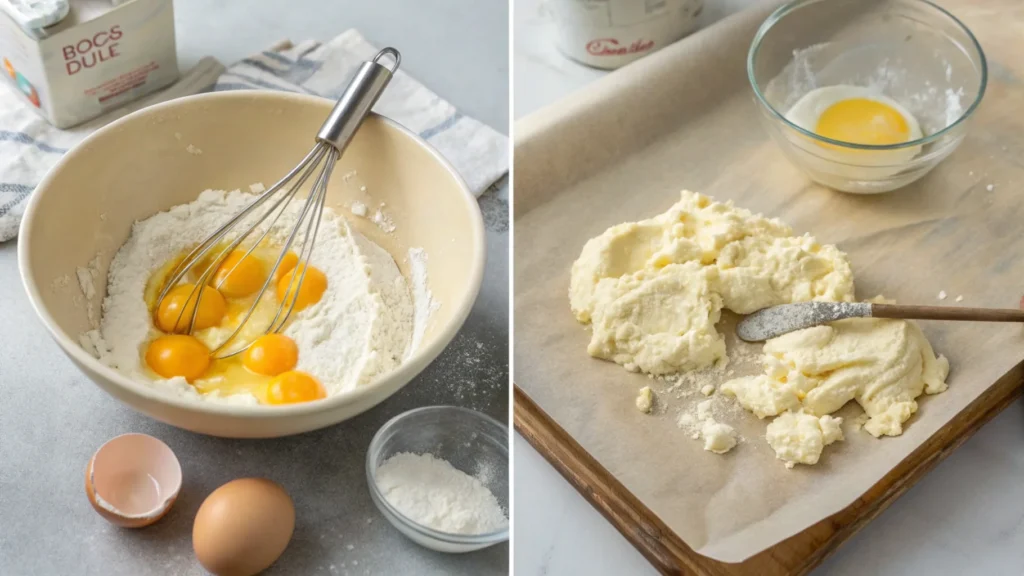
How to Use
Blending Cottage Cheese for a Creamy Texture
When exploring the question, Can cottage cheese be used on pizza?, one of the first steps to consider is preparing the cheese properly. Cottage cheese, by nature, is a bit lumpy. While this texture works well in many dishes, it may not suit everyone’s idea of a smooth, creamy pizza topping. Fortunately, blending it is an easy fix.
To achieve the desired consistency, use a blender or food processor. Simply add the cottage cheese and pulse until smooth. The result is a velvety texture that spreads evenly on your pizza base. Additionally, blending enhances its ability to meld with other ingredients, ensuring a harmonious flavor profile.
Pairing Cottage Cheese with Complementary Ingredients
The mild tanginess of cottage cheese makes it incredibly versatile. However, to truly elevate your pizza, pair it with toppings that enhance its natural flavor. For instance:
- Vegetables: Fresh spinach, zucchini slices, or caramelized onions work wonders.
- Proteins: Grilled chicken or turkey adds a savory, satisfying bite.
- Herbs and Spices: Sprinkle oregano, basil, or garlic powder to round out the taste.
Using cottage cheese in combination with these toppings creates a balanced, flavorful pizza. Moreover, it’s a healthier alternative to traditional cheese options, as it complements both rich and light ingredients beautifully.
Making this recipes
Ingredients Needed for a High-Protein Crust
Interestingly, Can cottage cheese be used on pizza? goes beyond toppings—it can even form the base of your pizza! Cottage cheese is a fantastic ingredient for a high-protein, low-carb crust. Here’s what you’ll need:
- 1 cup cottage cheese
- 2 eggs (as a binding agent)
- 1/2 cup almond flour (or all-purpose flour for a traditional twist)
- 1/4 tsp baking powder (for a slight lift)
- Seasonings like oregano, garlic powder, and a pinch of salt
These ingredients work together to create a crust that is not only nutritious but also sturdy enough to hold all your toppings.
Step-by-Step Preparation Guide
- Preheat the oven: Set it to 375°F (190°C) to ensure even baking.
- Blend the cottage cheese: Combine it with eggs until smooth.
- Mix the dry ingredients: In a separate bowl, whisk the flour, baking powder, and seasonings.
- Combine wet and dry ingredients: Slowly fold the dry mix into the cottage cheese blend. Stir until a thick batter forms.
- Spread the batter: On a baking sheet lined with parchment paper, spread the mixture into your desired pizza shape.
- Bake the crust: Bake for 10–15 minutes, or until the edges turn golden and the crust feels firm to the touch.
Once baked, you’ll have a nutritious crust ready for your favorite toppings. It’s a delightful answer to Can cottage cheese be used on pizza?, proving that this ingredient is incredibly versatile.
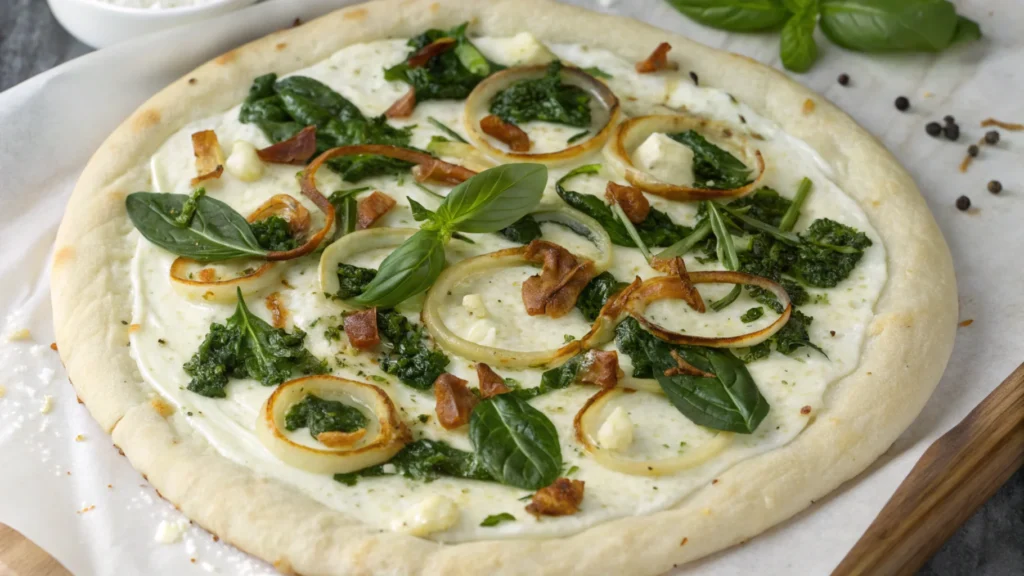
Creative Variations
White Pizza with Cottage Cheese
Can cottage cheese be used on pizza? Absolutely, and one of the most exciting ways to enjoy it is by creating a white pizza. Unlike traditional tomato-based pizzas, a white pizza uses a creamy sauce as its base. Cottage cheese, when blended, provides an excellent substitute for ricotta or heavy cream. Its mild tanginess pairs beautifully with herbs like basil and thyme, making every bite flavorful.
For a unique twist, top your white pizza with sautéed spinach, garlic, and caramelized onions. You can also drizzle pesto for an added burst of flavor. This variation is not only tasty but also lighter than its traditional counterparts.
Low-Carb and Gluten-Free Options
Cottage cheese isn’t just a great topping—it’s also a fantastic ingredient for those following low-carb or gluten-free diets. For instance, you can replace traditional pizza dough with a crust made from blended cottage cheese, eggs, and almond flour. It’s not only easy to make but also packed with protein, making it a guilt-free alternative.
Furthermore, topping this crust with fresh vegetables like zucchini and bell peppers enhances both the taste and nutritional value of your pizza. For more inspiration on crust ideas, check out the Cottage Cheese Pizza Crust Recipe on RecipesOlly.
Nutritional Benefits
High Protein Content for Satiety
One of the best answers to Can cottage cheese be used on pizza? lies in its impressive nutritional profile. Cottage cheese is naturally high in protein, making it an excellent choice for anyone looking to stay full longer. A protein-rich pizza can also help curb cravings and support muscle repair after workouts.
Low-Calorie and Low-Fat Alternative
Compared to traditional pizza cheeses like mozzarella or cheddar, cottage cheese is significantly lower in calories and fat. This makes it a perfect ingredient for those aiming to lose weight or maintain a healthy lifestyle. Moreover, it delivers creamy, cheesy goodness without the extra guilt.
Rich in Calcium and Other Nutrient
Cottage cheese is a powerhouse of calcium, which is essential for strong bones and teeth. Additionally, it’s packed with other nutrients like B vitamins and phosphorus, which are vital for overall health. Adding co-cheese to your pizza not only boosts its taste but also enhances its nutritional value.
Creative Cottage Cheese Pizza Variations
White Pizza with Cottage Cheese
Can this creamy dairy be used on pizza? Absolutely, and one of the most exciting ways to enjoy it is by creating a white pizza. Unlike traditional tomato-based pizzas, a white pizza uses a creamy sauce as its base. This soft curd cheese, when blended, provides an excellent substitute for ricotta or heavy cream. Its mild tanginess pairs beautifully with herbs like basil and thyme, making every bite flavorful.
For a unique twist, top your white pizza with sautéed spinach, garlic, and caramelized onions. You can also drizzle pesto for an added burst of flavor. This variation is not only tasty but also lighter than its traditional counterparts.
Low-Carb and Gluten-Free Options
Cottage cheese isn’t just a great topping—it’s also a fantastic ingredient for those following low-carb or gluten-free diets. For instance, you can replace traditional pizza dough with a crust made from blended cottage cheese, eggs, and almond flour. It’s not only easy to make but also packed with protein, making it a guilt-free alternative.
Furthermore, topping this crust with fresh vegetables like zucchini and bell peppers enhances both the taste and nutritional value of your pizza. For more inspiration on crust ideas, check out the Cottage Cheese Pizza Crust Recipe on RecipesOlly.
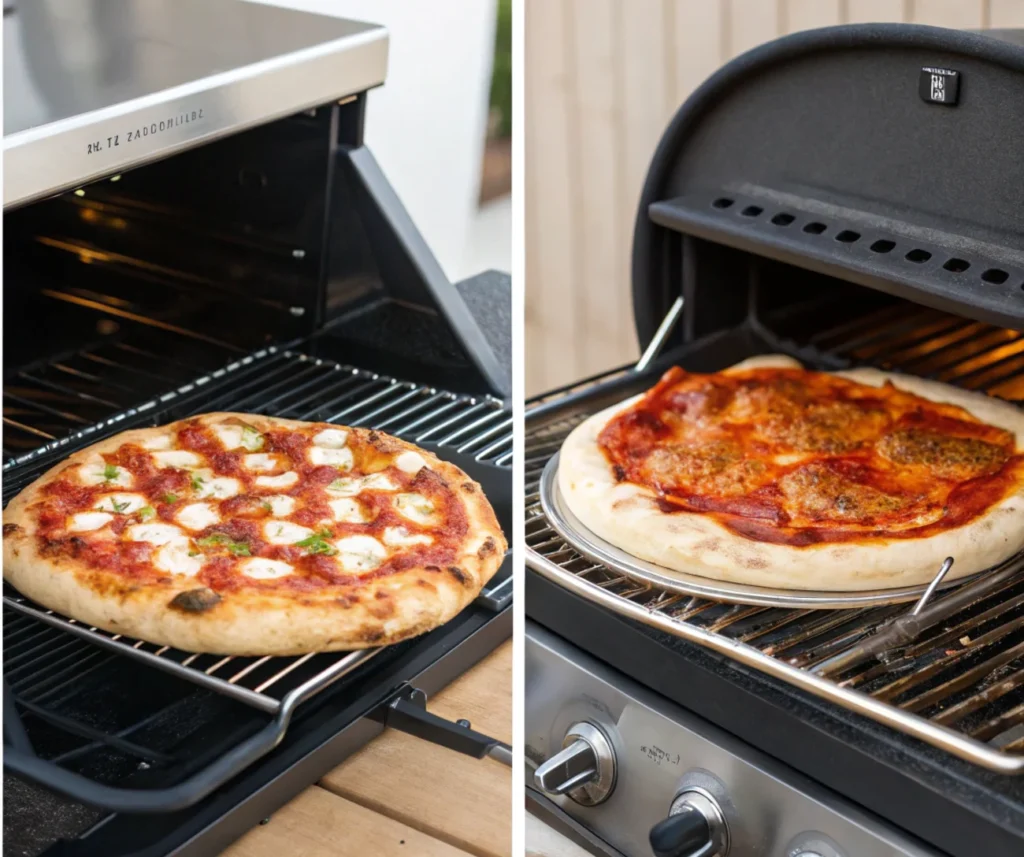
Nutritional Benefits of Using Cottage Cheese on Pizza
High Protein Content for Satiety
One of the best answers to Can cottage cheese be used on pizza? lies in its impressive nutritional profile. Cottage cheese is naturally high in protein, making it an excellent choice for anyone looking to stay full longer. A protein-rich pizza can also help curb cravings and support muscle repair after workouts.
Low-Calorie and Low-Fat Alternative
Compared to traditional pizza cheeses like mozzarella or cheddar, cottage cheese is significantly lower in calories and fat. This makes it a perfect ingredient for those aiming to lose weight or maintain a healthy lifestyle. Moreover, it delivers creamy, cheesy goodness without the extra guilt.
Rich in Calcium and Other Nutrients
Cottage cheese is a powerhouse of calcium, which is essential for strong bones and teeth. Additionally, it’s packed with other nutrients like B vitamins and phosphorus, which are vital for overall health. Adding cottage cheese to your pizza not only boosts its taste but also enhances its nutritional value.
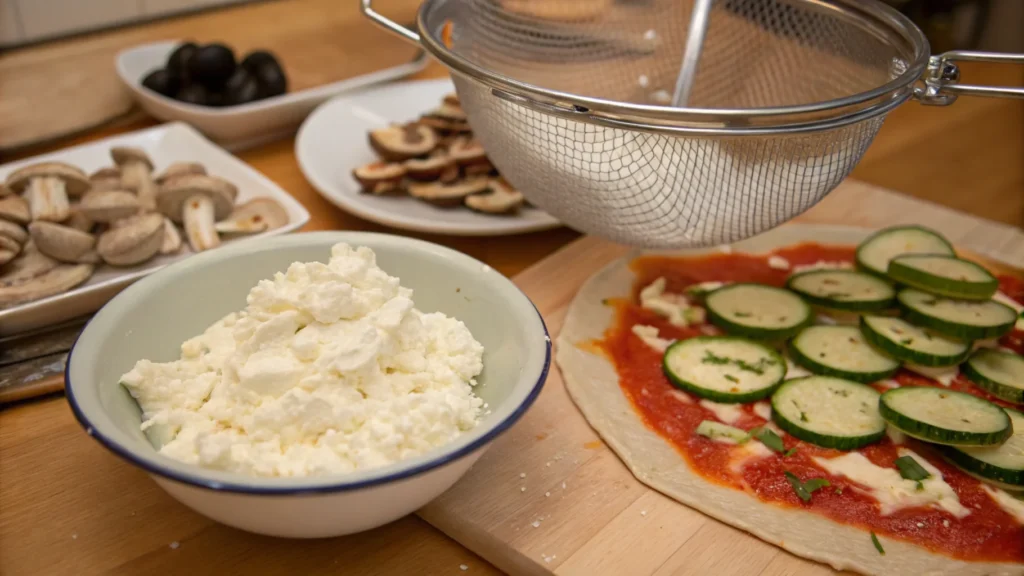
Common Mistakes to Avoid
Using Too Much Cottage Cheese
One mistake people make when asking, Can this creamy dairy be used on pizza?, is overloading the crust with too much of it. While this soft curd cheese is a fantastic topping, using too much can make the pizza overly moist or soggy. To avoid this, use a measured amount—typically about 1/2 cup for a medium-sized pizza.
Additionally, spreading the cottage cheese evenly across the base ensures that every bite is balanced. Overloading one section can create a dense, uneven texture that detracts from the overall experience.
Skipping the Blending Step
Another common error is skipping the step of blending the cottage cheese. Unblended cottage cheese can appear lumpy and may not spread evenly on your pizza. Blending not only creates a smooth texture but also allows the cheese to integrate better with the other toppings.
If you don’t have a blender, consider using a fork or whisk to break down the curds as much as possible. Taking this extra step can make a significant difference in the final product.
Frequently Asked Questions
Can Cottage Cheese Be Used Instead of Mozzarella?
Absolutely! Many people wonder, Can cottage cheese be used on pizza instead of mozzarella? While it doesn’t melt like mozzarella, cottage cheese offers a creamy, tangy flavor that works well in its own way. For those who miss the stretchiness of mozzarella, combining cottage cheese with shredded mozzarella can provide the best of both worlds.
Does Cottage Cheese Melt Like Pizza Cheese?
Cottage cheese doesn’t melt in the same way as traditional pizza cheeses. Instead of becoming stretchy and gooey, it maintains a soft, creamy texture. However, blending the cottage cheese before spreading it can help it mimic the consistency of melted cheese when baked.
What Are the Best Recipes Using Cottage Cheese on Pizza?
If you’re just starting to experiment, begin with simple recipes like a white pizza with cottage cheese, garlic, and spinach. Another great option is a veggie-loaded pizza featuring zucchini, bell peppers, and a sprinkle of parmesan for added flavor. The possibilities are endless when incorporating this versatile ingredient.
Conclusion: Why Cottage Cheese Deserves a Spot on Your Pizza
The question Can this creamy dairy be used on pizza? isn’t just a curiosity—it’s an opportunity to rethink how we approach this beloved dish. This soft curd cheese offers a nutritious, versatile, and flavorful alternative to traditional pizza ingredients. Whether used as a creamy topping, a base for white pizza, or even as part of a high-protein crust, it opens up endless possibilities for creating healthier yet indulgent meals.
From its tangy flavor to its rich protein content, this dairy option pairs beautifully with a variety of toppings and cooking methods. With simple preparation tips, you can avoid common pitfalls like sogginess or uneven textures. Plus, experimenting with unique combinations can make every pizza night an adventure.
So, why not give it a try? This alternative cheese isn’t just an answer to a question—it’s the start of a delicious, healthier chapter in your pizza-making journey. Dive in, get creative, and let this versatile dairy transform your next slice!

